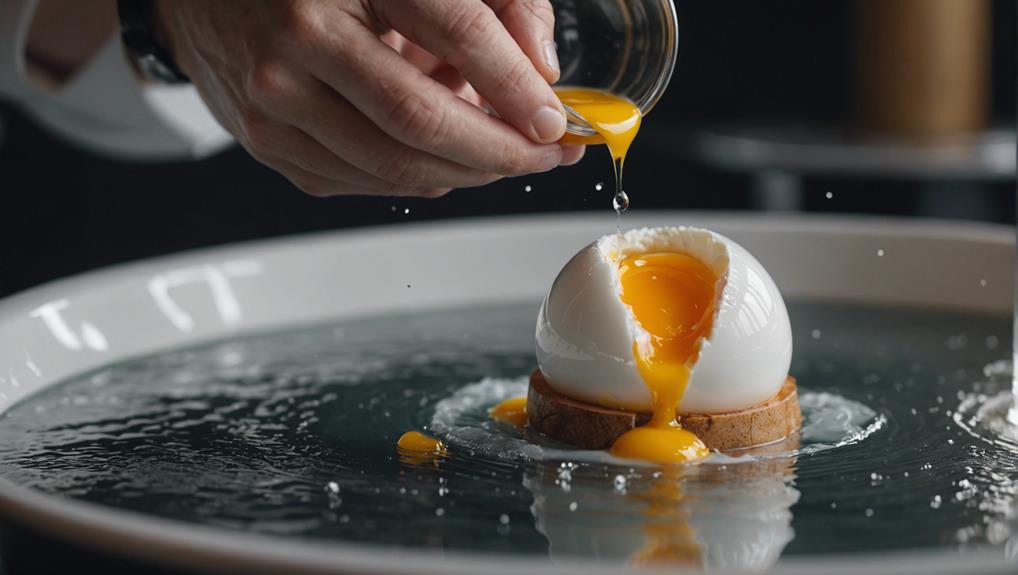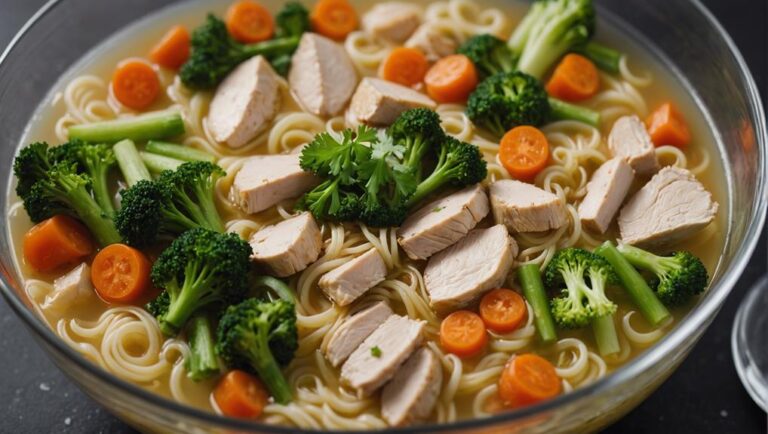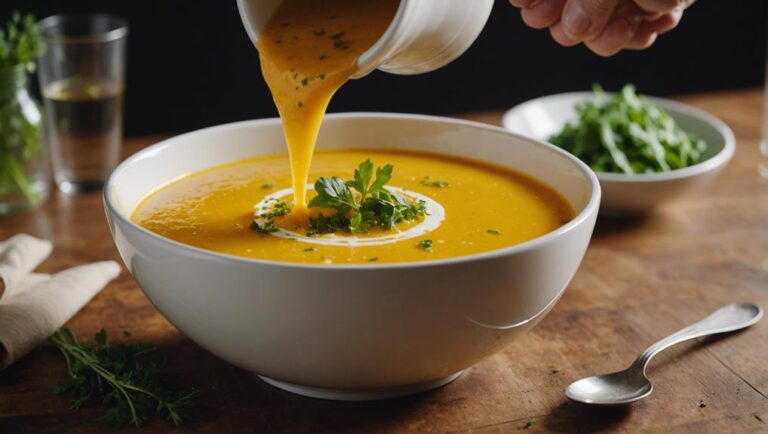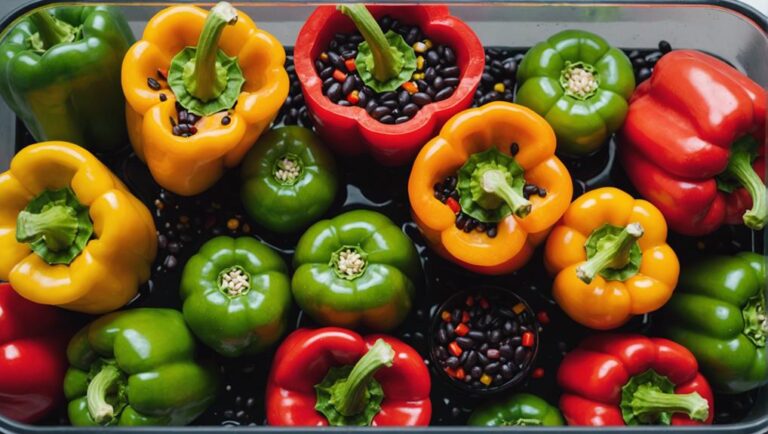"Sous Vide Precision Poached Eggs
In mastering sous vide precision poached eggs, you guarantee the texture and flavor by precisely regulating temperatures in a water bath. This modern technique cooks eggs at around 140°F (60°C) for an evenly smooth consistency. The importance of egg freshness guarantees whites stay compact and yolks rich. Variations like Sous Vide Egg Benedict offer superior taste with fresh eggs. Maintain water temperature accuracy for perfect results, as it impacts texture. Elevate your dishes with gourmet touches like Truffle Poached Eggs. Venture further to uncover essential tips for mastering the art of sous vide poached eggs.
What You Will Learn Here
- Precise temperature control for consistent texture.
- Vacuum-sealing and water bath ensure even cooking.
- Cooking at 140°F for perfect texture.
- Importance of fresh eggs for superior taste.
- Experiment with cooking times for customized results.
Egg-Poaching Technique Evolution
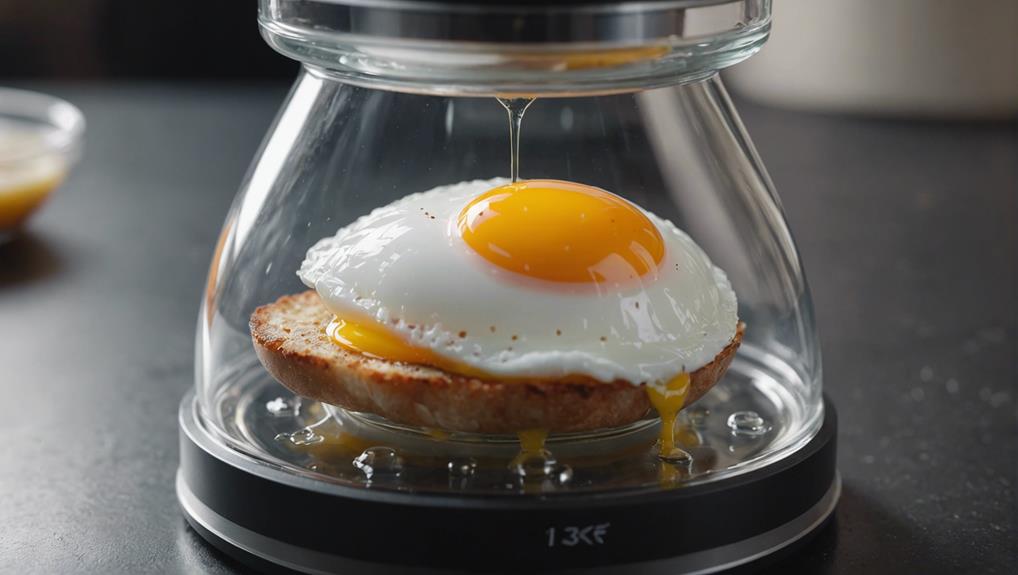
When examining the evolution of egg-poaching techniques, it becomes evident that historical methods relied on empirical knowledge and manual control, often resulting in inconsistent outcomes.
The advent of modern sous vide technology revolutionized this process by offering precise temperature regulation and extended cooking times, ensuring a more consistent and controlled poaching environment.
Historical Poaching Methods
Throughout history, the evolution of egg-poaching techniques has showcased a gradual refinement in culinary practices, highlighting a shift towards precision and consistency in achieving the perfect poached egg.
| Historical Poaching Methods | Description |
|---|---|
| Poaching History | Poaching has been used for centuries as a method to cook delicate foods. |
| Culinary Techniques | Traditional poaching involved simmering food in water or broth. |
| Egg Preservation | Eggs were historically preserved through techniques like pickling. |
| Traditional Methods | Ancient cultures often used natural substances like salt to preserve eggs. |
The historical methods of poaching eggs not only served as a means of cooking but also as a method of preserving this essential food source, showcasing the resourcefulness of early culinary practices.
Modern Sous Vide
In the evolution of egg-poaching techniques, the modern method of sous vide has revolutionized the precision and consistency in achieving perfectly poached eggs.
Sous vide cooking involves vacuum-sealing the eggs in a bag and immersing them in a precisely controlled water bath at a specific temperature, typically around 140°F (60°C). This temperature precision guarantees that the eggs cook gently and evenly, resulting in a creamy and consistent texture.
The cooking innovation of sous vide allows for a more controlled process compared to traditional poaching methods, where the water temperature can fluctuate, leading to inconsistent results.
Technique Comparison Benefits
Utilizing a comparative analysis of egg-poaching techniques reveals the distinct benefits that come with embracing the precision and consistency offered by sous vide cooking methods.
When considering the evolution of egg-poaching techniques, the comparison benefits become apparent. Traditional poaching methods often involve variables such as water temperature fluctuations, vinegar ratios, and egg freshness, leading to inconsistent results.
In contrast, sous vide cooking provides a controlled environment where eggs are cooked at a precise temperature for a specific duration, resulting in perfectly poached eggs every time. This technique evolution not only simplifies the process but also enhances the overall quality of the poached eggs by ensuring a consistent texture and yolk doneness.
Embracing the advancements in poaching techniques through sous vide cooking can elevate your culinary skills and delight your taste buds with perfectly poached eggs.
Egg Freshness Importance

Ensuring the freshness of your eggs is essential for achieving the best results when poaching, under vacuum. Fresh eggs contribute greatly to the overall quality of your poached eggs, affecting factors such as shell crackling and yolk consistency.
Here's why egg freshness matters:
- Shell crackling: Fresh eggs have a firmer egg white, which helps prevent the whites from spreading out too much in the water bath. This results in a cleaner, more intact poached egg with a smooth and intact outer layer.
- Yolk consistency: Fresh eggs offer a more consistent yolk texture, ensuring that it maintains the ideal creamy yet runny consistency when poached sous vide. This is vital for achieving that perfect ooze when you cut into your poached egg.
- Flavor profile: Fresh eggs have a more vibrant and nuanced flavor profile, enhancing the overall taste of your poached eggs. Stale eggs may have a dull taste that can detract from the dish.
- Aesthetics: Fresh eggs result in a visually appealing poached egg with a bright, lively yolk and pristine white, elevating the presentation of your dish.
Egg-cellent Poached Egg Variations
When considering variations for poached eggs, it's essential to explore options like Sous Vide Egg Benedict, Savory Truffle Poached Eggs, and Truffle-infused Poached Eggs. These variations offer a unique twist to the traditional poached egg, enhancing flavors and textures for a delightful culinary experience.
Experimenting with different ingredients and techniques can elevate your poached egg game to new levels of sophistication and taste.
Sous Vide Egg Benedict
For perfect Sous Vide Egg Benedict, precision in cooking time and temperature is essential to achieve the desired texture and consistency of the poached eggs. When preparing this exquisite dish, attention to detail is vital. Here's a breakdown of key elements to keep in mind:
- Temperature Control: Set your sous vide machine precisely to guarantee the eggs cook evenly.
- Timing: Follow the recommended cooking time to achieve the ideal consistency of the egg whites and yolks.
- Egg Freshness: Use fresh eggs for a superior taste and texture.
- Serving: Plate the poached eggs on English muffins with Canadian bacon and a velvety hollandaise sauce for a delightful culinary experience.
These factors will elevate your Sous Vide Egg Benedict to a gastronomic delight.
Savory Truffle Poached Eggs
Are you curious about how to infuse the rich and earthy flavor of truffles into your perfectly poached eggs? Truffle pairing can elevate your poached egg experience to a gourmet level, offering a luxurious touch to your dish.
Here's a quick guide to achieving savory Truffle Poached Eggs:
- Select Fresh Truffles: Opt for high-quality truffles to guarantee a robust and aromatic flavor profile.
- Infusion Technique: Infuse the truffle flavor into your poached eggs using truffle-infused oils or shaved truffle pieces.
- Gourmet Presentation: Serve your Truffle Poached Eggs on a bed of creamy risotto or alongside a truffle-infused hollandaise sauce for a decadent presentation.
- Taste Test: Experiment with different truffle varieties to find your preferred flavor combination for the ultimate gourmet delight.
Truffle-infused Poached Eggs
Infusing truffle essence into poached eggs enhances their flavor profile with a luxurious and earthy undertone, elevating the dish to a gourmet level. Truffle-infused poached eggs offer a delightful symphony of flavors that can be further enhanced with creative pairings. Here are some ideas to elevate your truffle-infused poached eggs:
- Truffle Pairing Ideas: Consider serving your truffle-infused poached eggs with shaved Parmesan cheese and a drizzle of truffle oil for an extra layer of richness.
- Poaching Tips and Tricks: To achieve the perfect poached egg texture, make sure your water is at a gentle simmer before adding the eggs and use a splash of vinegar to help the whites coagulate beautifully.
- Truffle Butter: Incorporate truffle butter into the poached egg dish for an intensified truffle experience.
- Herb Garnish: Finish your truffle-infused poached eggs with a sprinkle of fresh chives or parsley for a burst of freshness.
Egg Temperature Control Techniques
To achieve precise poached eggs, you must master egg temperature control techniques.
The key points to keep in mind are the specific temperature for the egg, the water bath method used, and the timing required for perfection.
Understanding and implementing these factors will result in consistently excellent poached eggs.
Temperature for Egg
Maintaining precise temperature control is essential when cooking eggs using sous vide techniques to guarantee the desired consistency and texture. To achieve the perfect poached egg, it's important to pay attention to the temperature consistency and cooking time. Eggs cooked at different temperatures can result in varying textures, from runny to firm. Water circulation in the sous vide machine guarantees even distribution of heat, helping to cook the eggs uniformly. Check out the table below for a quick reference guide on the ideal temperatures for different egg consistencies:
| Egg Texture | Temperature (°C) | Cooking Time (minutes) |
|---|---|---|
| Soft | 63 | 45 |
| Medium | 65 | 50 |
| Firm | 67 | 55 |
| Very Firm | 70 | 60 |
| Custard-like | 80 | 75 |
Water Bath Method
Moving from understanding the ideal temperatures for different egg consistencies, the Water Bath Method provides a precise technique for controlling egg temperature in sous vide cooking. To achieve temperature precision, you'll need a sous vide precision cooker, a container filled with water, and a vacuum-sealed bag with the eggs.
Set the water bath to the desired temperature based on your egg consistency preference – around 140°F for runny yolks and 167°F for firm whites and yolks. Once the water reaches the set temperature, carefully place the sealed eggs in the water bath. Cook for the recommended time – typically 45 minutes for runny yolks and up to 1 hour for firmer eggs. This method guarantees consistent results with minimal effort.
Timing for Perfect
For precise egg temperature control techniques, the key lies in mastering the timing during the sous vide cooking process. Temperature accuracy is essential to achieve the desired egg texture. Maintaining a consistent water temperature guarantees that the eggs cook evenly.
Cooking time plays a significant role in determining the yolk consistency. A shorter cooking time results in a runny yolk, while a longer cooking time yields a firmer yolk. By monitoring the cooking duration closely, you can achieve the perfect balance between a silky white and a creamy yolk.
Experimenting with different cooking times can help you customize the egg texture to your preference. Remember, precision in timing is the secret to mastering the art of sous vide poached eggs.
Final Thoughts
In conclusion, the sous vide precision poached eggs method offers a consistent and foolproof way to achieve perfectly cooked eggs every time. When comparing sous vide benefits to traditional methods, the key difference lies in temperature precision.
With sous vide cooking, you have precise control over the water temperature, ensuring that the eggs are cooked at the exact desired level of doneness. This precision is essential for maintaining ideal egg quality, as overcooking can lead to rubbery whites and hard yolks, while undercooking may result in runny or underdone eggs.
Frequently Asked Questions
Can I Reuse the Sous Vide Water for Poaching Eggs Multiple Times?
You can reuse the sous vide water for poaching eggs multiple times if it remains clear and clean. Be cautious of eggshell cracking to prevent contamination. Guarantee the water temperature and cooking time are consistent for best results.
How Do I Prevent the Eggshells From Cracking During the Sous Vide Process?
To safeguard eggshells from cracking during sous vide, maintain a gentle touch when handling, use fresh eggs, and gradually increase water temperature. Implement these sous vide tips for cracked shell prevention and elevate your cooking techniques.
Is It Safe to Consume Poached Eggs With a Runny Yolk?
Yes, it's safe to consume poached eggs with a runny yolk if they are pasteurized. Food safety guidelines recommend egg pasteurization to eliminate potential risks. Sous vide technique guarantees precise temperature control for the desired yolk consistency.
Can I Add Other Ingredients to the Sous Vide Bag With the Eggs?
You can enhance your sous vide egg dishes by experimenting with various flavor combinations in the bag. Adding ingredients like herbs, spices, or even cheese can infuse the eggs with new tastes. This technique allows for exciting texture variations in your egg dishes.
What Is the Best Way to Store Leftover Poached Eggs for Later Use?
To store leftover poached eggs, consider meal prepping by freezing them. This technique maintains freshness and allows for convenient future use. Alternatively, refrigeration can be an option for short-term storage, ensuring food safety and preserving quality.
Conclusion
To sum up, mastering the art of sous vide precision poached eggs requires attention to detail and precision. By understanding the evolution of egg-poaching techniques, the importance of egg freshness, and experimenting with different variations, you can achieve perfect results every time.
Utilizing temperature control techniques is essential in ensuring the desired consistency and texture of the eggs. With practice and dedication, you can elevate your breakfast game to a whole new level with these egg-cellent poached egg variations.
